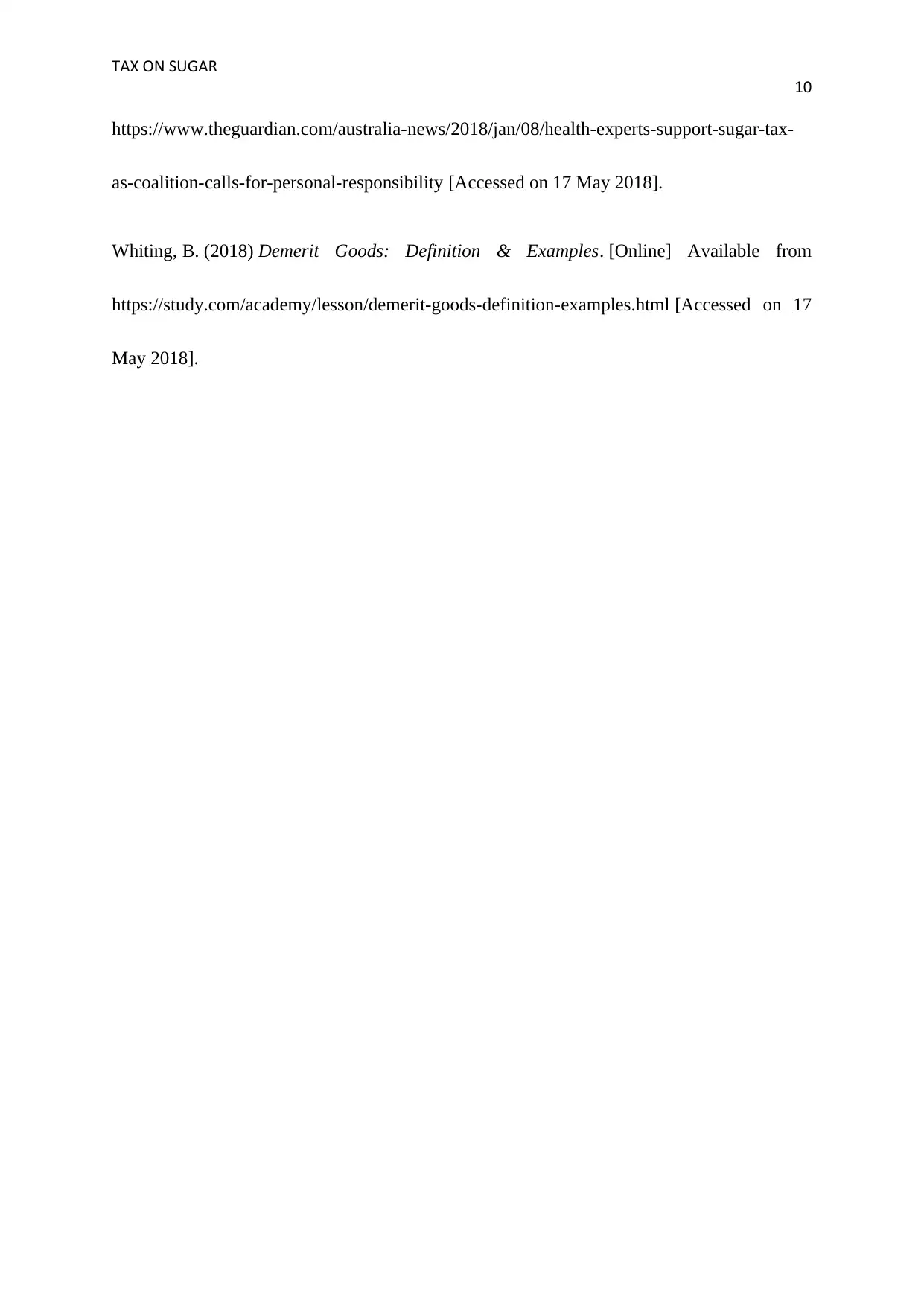Sugar Tax: An Economic Analysis of Impact and Effectiveness
VerifiedAdded on 2021/06/17
|11
|2105
|317
Report
AI Summary
This report provides a comprehensive economic analysis of sugar tax, examining its impact on the demand and supply of sugary drinks, consumer behavior, and public health outcomes. It discusses the rationale behind sugar tax, including its aim to reduce sugar consumption and combat health issues like diabetes and obesity. The report presents demand and supply curves to illustrate the effects of the tax on prices and consumption levels. It explores the concept of demerit goods and the factors contributing to the limited impact of the tax, such as consumer addiction and lack of information. The analysis further examines the implications of sugar tax on manufacturers, distributors, and the overall market, and it concludes by evaluating the effectiveness of sugar tax as a policy intervention, emphasizing the need for a combined approach including education, and advertising restrictions to reduce sugar consumption. The report references various studies and sources to support its arguments and findings.

Sugar Tax
Student Name:
Student Number:
Student Name:
Student Number:
Paraphrase This Document
Need a fresh take? Get an instant paraphrase of this document with our AI Paraphraser

TAX ON SUGAR
1
Sugar tax is a tax on sugary drinks it is also called a Sugar Sweetened Beverage Tax (I
news, 2018). It is introduced by various governments in their economy, the main purpose of
introduction of sugar tax is, reduce the consumption of Drinks contains sugar. There are so
many sugary drinks available in the market which contains high sugar level. The Demand of
sugary drinks with high sugar contain are increasing very rapidly worldwide. The target
audience for this type of drinks are kids and adults. From many studies and researches it has
been evolved that the intake of sugary drinks are very destructive for human body. Due to the
intake of sugary drinks the chances of getting diseases increases because it damages human
immune system.
In 2012, Hungary and France became the first countries to impose sugar tax and target
consumption of sugary drinks. France implement an excise duty of 7 eurocents which is
around 10 Australian cents per litre on beverages containing artificial sweeteners or added
sugar and Hungary applied public health taxes at fluctuating rates on various forms of soft
drinks (The economist, 2014).
In comparison to sugar food, sugar from drink enters into a human body really quickly and
that surpluses human pancreas and the liver which will increase the chances of getting
diseases like diabetes and heart problems. A study in 2010 stated that consuming one or two
sugar drinks a day may increase a risk of developing diabetes by 26%. Type 2 diabetes is
growing as a main health concern in many countries, and the main reason behind it is sugary
drinks. In 2015 1.6 million deaths was recorded due to type 2 diabetes (The guardian, 2018).
1
Sugar tax is a tax on sugary drinks it is also called a Sugar Sweetened Beverage Tax (I
news, 2018). It is introduced by various governments in their economy, the main purpose of
introduction of sugar tax is, reduce the consumption of Drinks contains sugar. There are so
many sugary drinks available in the market which contains high sugar level. The Demand of
sugary drinks with high sugar contain are increasing very rapidly worldwide. The target
audience for this type of drinks are kids and adults. From many studies and researches it has
been evolved that the intake of sugary drinks are very destructive for human body. Due to the
intake of sugary drinks the chances of getting diseases increases because it damages human
immune system.
In 2012, Hungary and France became the first countries to impose sugar tax and target
consumption of sugary drinks. France implement an excise duty of 7 eurocents which is
around 10 Australian cents per litre on beverages containing artificial sweeteners or added
sugar and Hungary applied public health taxes at fluctuating rates on various forms of soft
drinks (The economist, 2014).
In comparison to sugar food, sugar from drink enters into a human body really quickly and
that surpluses human pancreas and the liver which will increase the chances of getting
diseases like diabetes and heart problems. A study in 2010 stated that consuming one or two
sugar drinks a day may increase a risk of developing diabetes by 26%. Type 2 diabetes is
growing as a main health concern in many countries, and the main reason behind it is sugary
drinks. In 2015 1.6 million deaths was recorded due to type 2 diabetes (The guardian, 2018).

TAX ON SUGAR
2
Obesity is also turn out to be a big health concern all over the world because percentage of
obese and overweight peoples in every part of world is rising very rapidly. Addition of one
sugar sweetened beverage per day to normal diet can increase almost around 15 pounds of
weight over a course of one year (Harris, 2018).
The sugar hit can increases the chances of mood swings. The time sugar drink is been
consumed it gives an instant energy to the human body but after sometime, the body start
releasing insulin to cope up with the surge in sugar and this process lead to drop in the
endurance and energy level and this can be solved only if person taking more sugar. That
means consuming more sugar (Huffpost, 2015).
To control the obesity and improve the health of people many countries introduce a sugar
drink tax or soda tax which is designed to reduce the consumption of drink with added sugar.
The main aim of sugar tax is to reduce sugar contain in the drinks. The sugar tax levied on
manufacturers, it fully depend on manufacturer whether they will pay the amount of tax by
their own or they pass it on to the consumers. Drinks which contain 5-8g of sugar per 100ml
and those contain more than 8g per 100ml will be charged at variable tax rates. The increase
in percentage of tax will make soft drinks more expensive (Dennis and Abby, 2017).
When the sugar tax is levied on sugar drinks their prices will increase automatically. The
following demand and supply curve will show the effect of sugar tax on price and its impact
on demand and supply:
2
Obesity is also turn out to be a big health concern all over the world because percentage of
obese and overweight peoples in every part of world is rising very rapidly. Addition of one
sugar sweetened beverage per day to normal diet can increase almost around 15 pounds of
weight over a course of one year (Harris, 2018).
The sugar hit can increases the chances of mood swings. The time sugar drink is been
consumed it gives an instant energy to the human body but after sometime, the body start
releasing insulin to cope up with the surge in sugar and this process lead to drop in the
endurance and energy level and this can be solved only if person taking more sugar. That
means consuming more sugar (Huffpost, 2015).
To control the obesity and improve the health of people many countries introduce a sugar
drink tax or soda tax which is designed to reduce the consumption of drink with added sugar.
The main aim of sugar tax is to reduce sugar contain in the drinks. The sugar tax levied on
manufacturers, it fully depend on manufacturer whether they will pay the amount of tax by
their own or they pass it on to the consumers. Drinks which contain 5-8g of sugar per 100ml
and those contain more than 8g per 100ml will be charged at variable tax rates. The increase
in percentage of tax will make soft drinks more expensive (Dennis and Abby, 2017).
When the sugar tax is levied on sugar drinks their prices will increase automatically. The
following demand and supply curve will show the effect of sugar tax on price and its impact
on demand and supply:
⊘ This is a preview!⊘
Do you want full access?
Subscribe today to unlock all pages.

Trusted by 1+ million students worldwide

TAX ON SUGAR
3
(Source: Pettinger, 2017)
The above stated demand and
supply curve shows that
original price of sugar drink
was P1 the Quantity
Demand was Q1 and when the
price of sugar drink was increased because of sugar tax new or increased price was P2 and at
that point the Quantity Demanded was Q2. SMC stands for Social Marginal Cost and PMC
stands for Personal Marginal cost. P is for price, Q is for Quantity and D is for Demand.
It can be clear from the demand curve that the consumption of sugar drinks is not really
effected by the levy of sugar tax. There is a very slight shift in the demand curve is recorded.
Curve has shift from PMC to SMC and the loss area called deadweight welfare loss, that area
shows, after the rise in prices of sugar drink the demand will not get much affected. The
deadweight welfare area indicates the extra amount of revenue received by the government,
which is generated by levy of sugar tax on sugar drinks and that extra tax amount will be used
for the welfare of the society and for the social purpose like heath improvement plans and
many other plans and polices of the government (Pettinger, 2017).
Figure 1: Demand and supply curve
3
(Source: Pettinger, 2017)
The above stated demand and
supply curve shows that
original price of sugar drink
was P1 the Quantity
Demand was Q1 and when the
price of sugar drink was increased because of sugar tax new or increased price was P2 and at
that point the Quantity Demanded was Q2. SMC stands for Social Marginal Cost and PMC
stands for Personal Marginal cost. P is for price, Q is for Quantity and D is for Demand.
It can be clear from the demand curve that the consumption of sugar drinks is not really
effected by the levy of sugar tax. There is a very slight shift in the demand curve is recorded.
Curve has shift from PMC to SMC and the loss area called deadweight welfare loss, that area
shows, after the rise in prices of sugar drink the demand will not get much affected. The
deadweight welfare area indicates the extra amount of revenue received by the government,
which is generated by levy of sugar tax on sugar drinks and that extra tax amount will be used
for the welfare of the society and for the social purpose like heath improvement plans and
many other plans and polices of the government (Pettinger, 2017).
Figure 1: Demand and supply curve
Paraphrase This Document
Need a fresh take? Get an instant paraphrase of this document with our AI Paraphraser

TAX ON SUGAR
4
The slight shift in demand curve is because of the additive behaviour of the consumer. The
additive behaviour of consumer is a factor which will not lead the demand curve shift much
because the consumers are very much related to the product. And in the case of sugar drinks
also this has been noticed that the consumers are so much fond of sugar drink that if the price
goes high, they will not stop consuming it.
Sugar drinks are imposing high external cost on the people. And these external costs are the
reason behind higher cost imposed on the national health services. The poor health of citizen
adversely affects the working and productivity of the people. And this is the main cause
which increases the social cost of sugar consumption more than the private cost (Pettinger,
2017).
Goods which place themselves as addictive goods in the market are known as demerit goods.
In context of external cost sugary drinks can be categorised as a demerit good. They are
called demerit good, since the general public is not aware about the private cost involve with
the sugar consumption but they may be aware about it bad effects on the health, but still they
won’t reduce the consumption of sugar because they have become addictive to it (Whiting,
2018).
There are three main factors behind the slight shift in demand curve or deadweight welfare
loss area. First, the lack of information among people, the general people are not aware about
the health consequences related to the consumption of sugar drinks and in condition of lack
4
The slight shift in demand curve is because of the additive behaviour of the consumer. The
additive behaviour of consumer is a factor which will not lead the demand curve shift much
because the consumers are very much related to the product. And in the case of sugar drinks
also this has been noticed that the consumers are so much fond of sugar drink that if the price
goes high, they will not stop consuming it.
Sugar drinks are imposing high external cost on the people. And these external costs are the
reason behind higher cost imposed on the national health services. The poor health of citizen
adversely affects the working and productivity of the people. And this is the main cause
which increases the social cost of sugar consumption more than the private cost (Pettinger,
2017).
Goods which place themselves as addictive goods in the market are known as demerit goods.
In context of external cost sugary drinks can be categorised as a demerit good. They are
called demerit good, since the general public is not aware about the private cost involve with
the sugar consumption but they may be aware about it bad effects on the health, but still they
won’t reduce the consumption of sugar because they have become addictive to it (Whiting,
2018).
There are three main factors behind the slight shift in demand curve or deadweight welfare
loss area. First, the lack of information among people, the general people are not aware about
the health consequences related to the consumption of sugar drinks and in condition of lack

TAX ON SUGAR
5
of knowledge or information the consumer consume the sugar drinks. Second the sugary
drinks are easily available in the market and main reason is they are available at very cheap
price. Third the advertisement, the sugary drinks are advertised by the companies on large
scale and the advertisement are very attractive which forces kids and adults to consume soft
drink. These are main reasons due to which the consumption of sugar drinks is not reducing
(The balance, 2018).
The average resident of Australia consumes almost around two hundred and thirty eight
teaspoons of sugar ever week deprived of realising that how much sugar content is hidden in
soft drinks and other processed food, and this is an example of information failure the
consumers are not aware about the bad effects of sugar and the amount of sugar contain in the
sugar drinks. In Australia the consumption of sugar in form of sugary drinks has increased by
30% in 10 years. This is mainly based on the standard serving size as earlier soft drinks are
available in 375 ml pack but now almost all companies are selling there drinks in 600ml
bottles (Fessenden, 2018).
5
of knowledge or information the consumer consume the sugar drinks. Second the sugary
drinks are easily available in the market and main reason is they are available at very cheap
price. Third the advertisement, the sugary drinks are advertised by the companies on large
scale and the advertisement are very attractive which forces kids and adults to consume soft
drink. These are main reasons due to which the consumption of sugar drinks is not reducing
(The balance, 2018).
The average resident of Australia consumes almost around two hundred and thirty eight
teaspoons of sugar ever week deprived of realising that how much sugar content is hidden in
soft drinks and other processed food, and this is an example of information failure the
consumers are not aware about the bad effects of sugar and the amount of sugar contain in the
sugar drinks. In Australia the consumption of sugar in form of sugary drinks has increased by
30% in 10 years. This is mainly based on the standard serving size as earlier soft drinks are
available in 375 ml pack but now almost all companies are selling there drinks in 600ml
bottles (Fessenden, 2018).
⊘ This is a preview!⊘
Do you want full access?
Subscribe today to unlock all pages.

Trusted by 1+ million students worldwide

TAX ON SUGAR
6
Figure 2: Consumption before tax levy Figure 3: Consumption after tax levy
(Source: Oxford Economic, 2016)
The above stated graphs show that introduction of sugar tax on soft drinks not only affects the
overall value and volume of soft drink sales but also the market share. If the prices of soft
drink rise due to levy of sugar tax the demand of customers will shift from soft drinks to other
drinks which are less in price. The customers switch from product with high volume of added
sugar to drinks on which tax is not levied and drinks which contain less amount of sugar. The
stated changes have wider economic impact on manufactures and distributors of the soft
drinks, and other who are attached with economic activity (Cormack, 2016).
The sugar tax is imposed with the main motive of reduce in the consumption of sugar drinks
and improve health of people, but due to many reasons the consumption is not reduced and
the motive of improving health of people is not attain. Despite increasing awareness about the
health risk associate with sugar drinks and extensive promotion of international and national
nutritional guiding principle to encourage reduction of sugar consumption, sugar sweetened
6
Figure 2: Consumption before tax levy Figure 3: Consumption after tax levy
(Source: Oxford Economic, 2016)
The above stated graphs show that introduction of sugar tax on soft drinks not only affects the
overall value and volume of soft drink sales but also the market share. If the prices of soft
drink rise due to levy of sugar tax the demand of customers will shift from soft drinks to other
drinks which are less in price. The customers switch from product with high volume of added
sugar to drinks on which tax is not levied and drinks which contain less amount of sugar. The
stated changes have wider economic impact on manufactures and distributors of the soft
drinks, and other who are attached with economic activity (Cormack, 2016).
The sugar tax is imposed with the main motive of reduce in the consumption of sugar drinks
and improve health of people, but due to many reasons the consumption is not reduced and
the motive of improving health of people is not attain. Despite increasing awareness about the
health risk associate with sugar drinks and extensive promotion of international and national
nutritional guiding principle to encourage reduction of sugar consumption, sugar sweetened
Paraphrase This Document
Need a fresh take? Get an instant paraphrase of this document with our AI Paraphraser

TAX ON SUGAR
7
soft drinks stay popular, mainly among adolescents and children. From point of view of
population health reducing in consumption of sugary drinks is highly desirable, the
government need to take some important decision (Oxford economic, 2016).
Sugar tax not really fails, because the tax was doing well and generating revenues for the
government it is a failure of the policy that was designed by the authorities. The levying of
sugar tax on the sugar drink is not the best policy to reduce the sugar consumption. The most
effective strategy will be combining all policy such as education, tax and ban on
advertisement. These all can play an effective role in reducing sugar consumption.
7
soft drinks stay popular, mainly among adolescents and children. From point of view of
population health reducing in consumption of sugary drinks is highly desirable, the
government need to take some important decision (Oxford economic, 2016).
Sugar tax not really fails, because the tax was doing well and generating revenues for the
government it is a failure of the policy that was designed by the authorities. The levying of
sugar tax on the sugar drink is not the best policy to reduce the sugar consumption. The most
effective strategy will be combining all policy such as education, tax and ban on
advertisement. These all can play an effective role in reducing sugar consumption.

TAX ON SUGAR
8
References
Cormack, L. (2016) Sugar tax could save 1600 lives, raise $400 million, Australian research
shows. [Online] Available from https://www.smh.com.au/business/consumer-affairs/sugar-
tax-could-save-1600-lives-raise-400-million-australian-research-shows-20160413-
go5mgh.html [Accessed on 17 May 2018].
Dennis, A. and Abby, B.S. (2017) Sugar Price Supports and Taxation: A Public Health
Policy [Online] Paradox. Available from
https://journals.lww.com/nutritiontodayonline/Fulltext/2017/05000/
Sugar_Price_Supports_and_Taxation__A_Public_Health.6.aspx [Accessed on 17 May 2018].
Fessenden, S. (2018) How sugar taxes punish the people. [Online] Available from
https://theconversation.com/how-sugar-taxes-punish-the-people-94014 [Accessed on 17 May
2018].
Harris, B. (2018) Will a sugar tax help reduce obesity. [Online] Available from
https://www.weforum.org/agenda/2018/03/will-a-sugar-tax-help-reduce-obesity/ [Accessed
on 17 May 2018].
Huffpost, (2015) This Is What Sugar Does To Your Brain. [Online] Available from
https://www.huffingtonpost.in/entry/sugar-brain-mental-health_n_6904778 [Accessed on 17
May 2018].
8
References
Cormack, L. (2016) Sugar tax could save 1600 lives, raise $400 million, Australian research
shows. [Online] Available from https://www.smh.com.au/business/consumer-affairs/sugar-
tax-could-save-1600-lives-raise-400-million-australian-research-shows-20160413-
go5mgh.html [Accessed on 17 May 2018].
Dennis, A. and Abby, B.S. (2017) Sugar Price Supports and Taxation: A Public Health
Policy [Online] Paradox. Available from
https://journals.lww.com/nutritiontodayonline/Fulltext/2017/05000/
Sugar_Price_Supports_and_Taxation__A_Public_Health.6.aspx [Accessed on 17 May 2018].
Fessenden, S. (2018) How sugar taxes punish the people. [Online] Available from
https://theconversation.com/how-sugar-taxes-punish-the-people-94014 [Accessed on 17 May
2018].
Harris, B. (2018) Will a sugar tax help reduce obesity. [Online] Available from
https://www.weforum.org/agenda/2018/03/will-a-sugar-tax-help-reduce-obesity/ [Accessed
on 17 May 2018].
Huffpost, (2015) This Is What Sugar Does To Your Brain. [Online] Available from
https://www.huffingtonpost.in/entry/sugar-brain-mental-health_n_6904778 [Accessed on 17
May 2018].
⊘ This is a preview!⊘
Do you want full access?
Subscribe today to unlock all pages.

Trusted by 1+ million students worldwide

TAX ON SUGAR
9
I news, (2018) Sugar tax: what is changing about fizzy drinks – and how much will it cost?.
[Online] Available from https://inews.co.uk/news/uk/sugar-tax-fizzy-drinks-what-is-
changing-about-my-drinks/ [Accessed on 17 May 2018].
Oxford economic, (2016) THE ECONOMIC IMPACT OF THE SOFT DRINKS LEVY THE
ECONOMIC IMPACT OF THE SOFT DRINKS LEVY. [Online]Available from
http://www.britishsoftdrinks.com/write/MediaUploads/Publications/The_Economic_Impact_
of_the_Soft_Drinks_Levy.pdf [Accessed on 17 May 2018].
Pettinger, T. (2017) Sugar tax debate. [Online] Available from
https://www.economicshelp.org/blog/14884/economics/sugar-tax-debate/ [Accessed on 17
May 2018].
The balance, (2018) Shift in Demand Curve. [Online] Available from
https://www.thebalance.com/shift-in-demand-curve-when-price-doesn-t-matter-3305720
[Accessed on 17 May 2018].
The economist, (2014) Taxing sugary drinks Stopping slurping. [Online] Available from
https://www.economist.com/finance-and-economics/2015/11/26/stopping-slurping [Accessed
on 17 May 2018].
The guardian, (2018) Health experts support sugar tax as Coalition calls for 'personal
responsibility'. [Online] Available from
9
I news, (2018) Sugar tax: what is changing about fizzy drinks – and how much will it cost?.
[Online] Available from https://inews.co.uk/news/uk/sugar-tax-fizzy-drinks-what-is-
changing-about-my-drinks/ [Accessed on 17 May 2018].
Oxford economic, (2016) THE ECONOMIC IMPACT OF THE SOFT DRINKS LEVY THE
ECONOMIC IMPACT OF THE SOFT DRINKS LEVY. [Online]Available from
http://www.britishsoftdrinks.com/write/MediaUploads/Publications/The_Economic_Impact_
of_the_Soft_Drinks_Levy.pdf [Accessed on 17 May 2018].
Pettinger, T. (2017) Sugar tax debate. [Online] Available from
https://www.economicshelp.org/blog/14884/economics/sugar-tax-debate/ [Accessed on 17
May 2018].
The balance, (2018) Shift in Demand Curve. [Online] Available from
https://www.thebalance.com/shift-in-demand-curve-when-price-doesn-t-matter-3305720
[Accessed on 17 May 2018].
The economist, (2014) Taxing sugary drinks Stopping slurping. [Online] Available from
https://www.economist.com/finance-and-economics/2015/11/26/stopping-slurping [Accessed
on 17 May 2018].
The guardian, (2018) Health experts support sugar tax as Coalition calls for 'personal
responsibility'. [Online] Available from
Paraphrase This Document
Need a fresh take? Get an instant paraphrase of this document with our AI Paraphraser

TAX ON SUGAR
10
https://www.theguardian.com/australia-news/2018/jan/08/health-experts-support-sugar-tax-
as-coalition-calls-for-personal-responsibility [Accessed on 17 May 2018].
Whiting, B. (2018) Demerit Goods: Definition & Examples. [Online] Available from
https://study.com/academy/lesson/demerit-goods-definition-examples.html [Accessed on 17
May 2018].
10
https://www.theguardian.com/australia-news/2018/jan/08/health-experts-support-sugar-tax-
as-coalition-calls-for-personal-responsibility [Accessed on 17 May 2018].
Whiting, B. (2018) Demerit Goods: Definition & Examples. [Online] Available from
https://study.com/academy/lesson/demerit-goods-definition-examples.html [Accessed on 17
May 2018].
1 out of 11
Related Documents
Your All-in-One AI-Powered Toolkit for Academic Success.
+13062052269
info@desklib.com
Available 24*7 on WhatsApp / Email
![[object Object]](/_next/static/media/star-bottom.7253800d.svg)
Unlock your academic potential
Copyright © 2020–2025 A2Z Services. All Rights Reserved. Developed and managed by ZUCOL.





